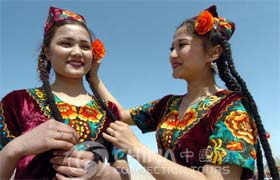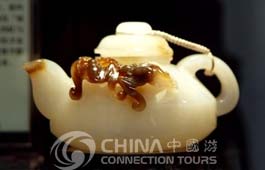Location
Hetian is also known as Hotan or Khotan. It is an oasis lying in the west of the Yurungkash River (White Jade River). The city extends along the northern foot of Kunlun Mountain, south of the Takla Makan Desert. Its land is fertile and loamy with the Yunrungkash and Karakax Rivers flowing through it.
History
 Situated in the southern part of Xinjiang Uyghur Autonomous Region in northwestern China, Hetian City has a long history and rich culture. The city served as the capital for the Kingdom of Khotan in ancient times. It has long been famous for its silk, jade and pottery products, and as one of the important stops on the ancient "Silk Road." The oasis of Hetian lay at the southern branch of the "Silk Road" and linked China with Tibet, India and Central Asia. Anciently, the city was an important commercial and cultural center where not only goods, but also technology, religion and art met and influenced each other.
Situated in the southern part of Xinjiang Uyghur Autonomous Region in northwestern China, Hetian City has a long history and rich culture. The city served as the capital for the Kingdom of Khotan in ancient times. It has long been famous for its silk, jade and pottery products, and as one of the important stops on the ancient "Silk Road." The oasis of Hetian lay at the southern branch of the "Silk Road" and linked China with Tibet, India and Central Asia. Anciently, the city was an important commercial and cultural center where not only goods, but also technology, religion and art met and influenced each other.
People & Religion
 Historically, Hetian served as a center for Buddhist learning under the Kushana Empire (269-231BC). Buddhism prevailed in Hetian for hundreds of years until the 11th century AD, when Islam began to spread through Xinjiang after Muslim Arabs conquered the oasis. Today the population of the city is almost exclusively Uyghur minority people, whose religion is Islam. They wear little embroidered hats to distinguish themselves from Uyghur people from other places.
Historically, Hetian served as a center for Buddhist learning under the Kushana Empire (269-231BC). Buddhism prevailed in Hetian for hundreds of years until the 11th century AD, when Islam began to spread through Xinjiang after Muslim Arabs conquered the oasis. Today the population of the city is almost exclusively Uyghur minority people, whose religion is Islam. They wear little embroidered hats to distinguish themselves from Uyghur people from other places.
The local people are very versatile and proud that Hetian is the home of the music and dance of the Uyghur People. Twelve Mukams, a musical composition, which was created by a Uyghur girl in Hetian, is regarded as the heart and soul of Uyghur music and is still very popular today.
Tourism Resources
 Many people know about Hetian because of the famous Hetianese jade. There is an abundance of historic relics, unique geographical features and various specialties that appeal to thousands of tourists from home and abroad each year. There are several ancient cities' ruins left from Hetian's tempestuous history, with a large number of precious historical relics and artifacts. Perishable items such as wood and fabric have been preserved beneath the desert sand, and Hetian is an attractive place for archaeologists.
Many people know about Hetian because of the famous Hetianese jade. There is an abundance of historic relics, unique geographical features and various specialties that appeal to thousands of tourists from home and abroad each year. There are several ancient cities' ruins left from Hetian's tempestuous history, with a large number of precious historical relics and artifacts. Perishable items such as wood and fabric have been preserved beneath the desert sand, and Hetian is an attractive place for archaeologists.

